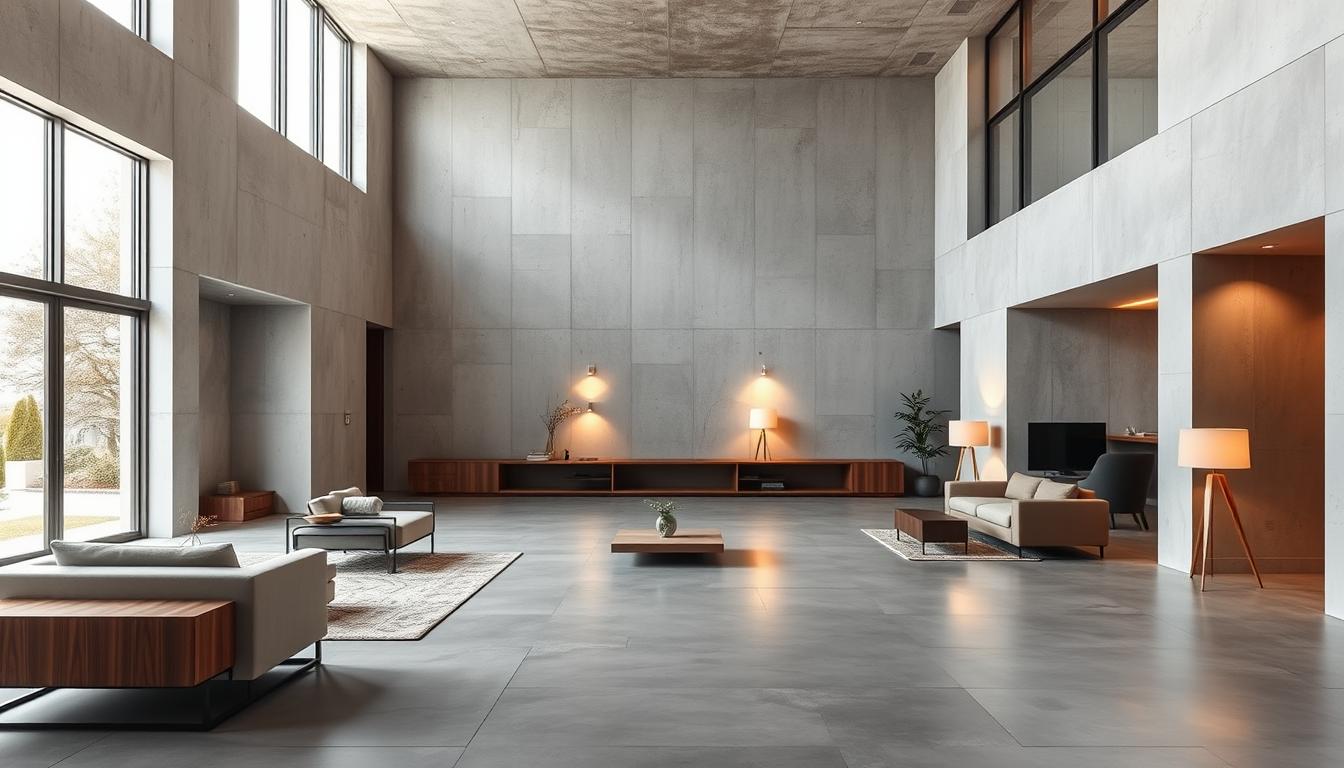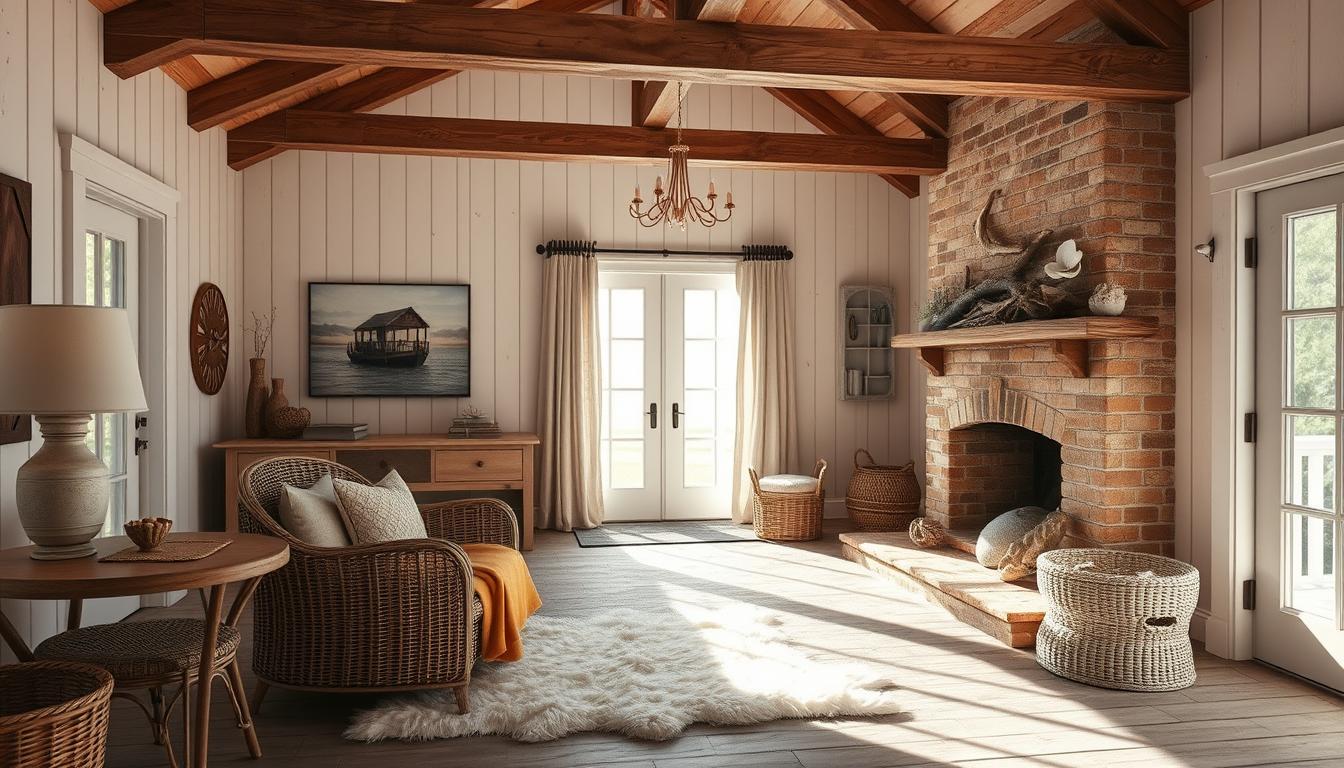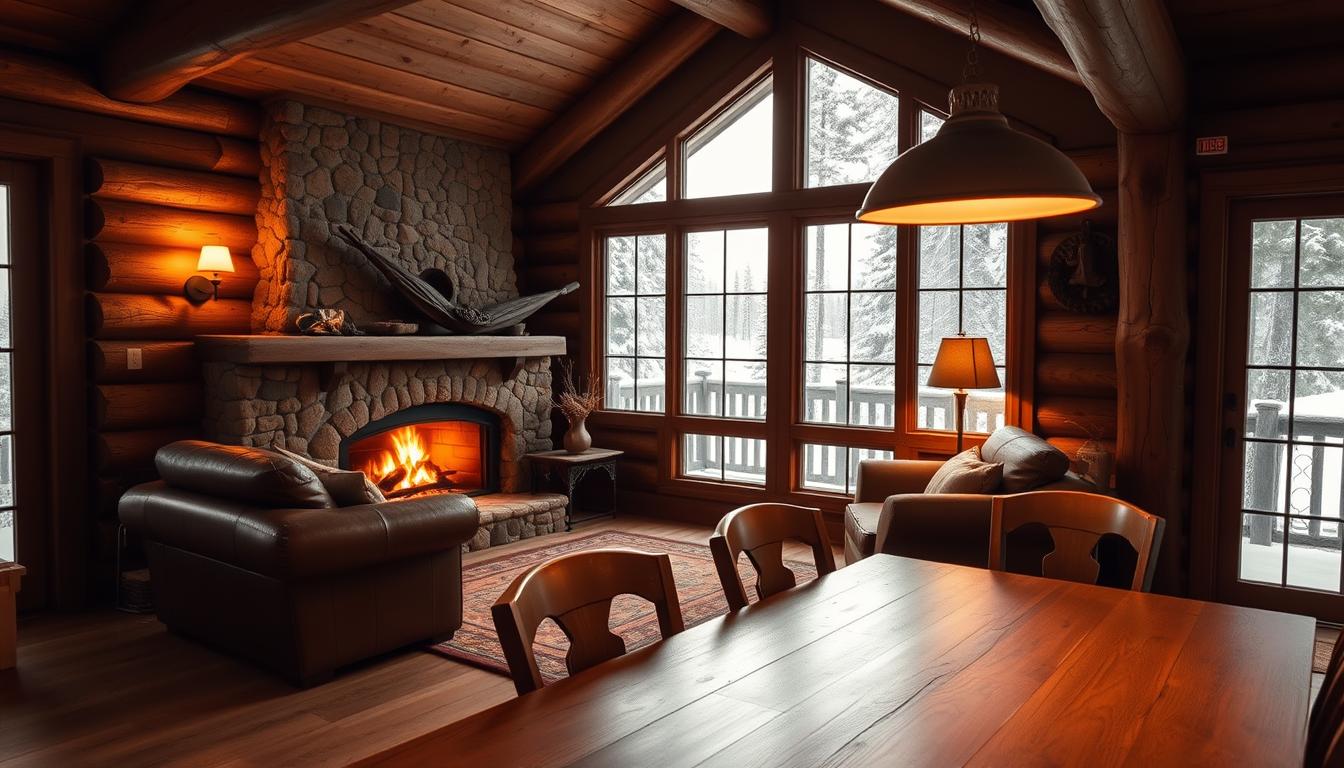We’re seeing a big change in how we view concrete interior design. It’s no longer just for industrial spaces. Now, it’s a top pick for chic and modern spaces. This change is because of its flexibility and the special look it adds to modern concrete design.
Looking into concrete interior design, we see it can fit many styles and needs. This makes it a hit with designers and homeowners. The outcome is chic concrete interiors that are both trendy and useful.
Key Takeaways
- Concrete is becoming a popular choice for interior design due to its versatility.
- It can be adapted to various styles and conditions.
- Modern concrete design offers a unique aesthetic.
- Chic concrete interiors are both stylish and functional.
- Homeowners and designers are increasingly favoring concrete for its adaptability.
What is Concrete Interior Design?
Concrete is changing interior design with its durability and versatility. It combines industrial looks with modern design, making it very popular in homes and offices.
Definition and Key Features
Concrete interior design uses concrete as the main material in spaces. It’s known for its industrial charm and modern sophistication. Concrete is durable, versatile, and can be shaped in many ways.
Concrete can mix well with other materials like wood, metal, and glass. This creates a unique, modern look. It’s often seen in industrial interior design and urban concrete style, where concrete’s raw look is valued.
Historical Context
Concrete has been around for ages, but in interior design, it’s a newer trend. It was once used mainly for building foundations. Now, it’s used for floors, walls, and countertops.
The rise of concrete in design comes from a love for contemporary cement design and eco-friendly materials. Architects and designers found concrete can make spaces both beautiful and practical.
Modern Trends
Concrete interior design is now more popular than ever. People love its modern, industrial look. Trends include polished floors, concrete countertops, and decorative walls.
These elements add a urban concrete style to spaces. They’re also durable and easy to care for. As we seek sustainable designs, concrete will likely stay a top choice.
The Aesthetic Appeal of Concrete
Concrete has changed interior design, mixing industrial chic with modern style. It’s versatile and fits many styles, making it appealing.
Industrial Charm
Concrete interiors have an industrial charm that’s both trendy and timeless. This look is perfect for loft-style apartments and urban renovations. Exposed concrete stands out as a statement piece.
Using concrete in design honors its industrial past. It brings authenticity and modernity to spaces.
Minimalist Elegance
Concrete fits well with minimalist design. Its simplicity and clean look are great for elegant, clutter-free interiors. Minimalist concrete interiors often have polished surfaces that reflect light and make spaces feel larger.
This minimalist concrete design is about beauty and function. It focuses on clean lines and simplicity, making spaces both beautiful and practical.
Versatile Color Palettes
Concrete isn’t just gray; it comes in many colors. You can find warm tones in stained concrete or cool industrial hues in raw concrete. Designers can stain or coat concrete to get the trendy concrete home decor they want.
Customizing concrete’s color makes it fit many design schemes. It can be a main feature or an accent, adding unique concrete decor to any space.
Benefits of Concrete Interiors
Concrete interiors are gaining popularity in modern design. They offer a mix of practicality and beauty. This makes them a great choice for homes and businesses.
Durability and Longevity
Concrete is known for its durability and longevity. It can handle a lot of use without getting worn out. This makes it perfect for places that get a lot of foot traffic.
Unlike other materials, concrete doesn’t need to be replaced often. It can last for decades with just a little care.
Low Maintenance Requirements
Concrete interiors are also easy to take care of. They don’t need to be polished or cleaned often. A simple cleaning routine keeps them looking great.
This is great for busy homes and businesses. It saves time and resources.
“The durability and low maintenance of concrete make it an economical choice in the long run.” – Expert in Modern Concrete Design
Sustainability Considerations
Concrete also has sustainability considerations. Modern concrete designs often use recycled materials. This reduces environmental harm.
Concrete also helps control indoor temperatures. This can lower the need for heating and cooling.
Choosing concrete for interiors means picking a material that’s good for the planet and your wallet. As more people look for sustainable design, concrete will stay a top choice for eco-friendly spaces.
Types of Concrete Finishes
Concrete is versatile, with many finishes to choose from. Each finish has its own look. You can stain, polish, or shape concrete to fit your design.
Polished Concrete
Polished concrete is made by grinding and polishing the surface. It looks great and is durable. Polished concrete floors are loved for their sleek look and industrial feel.
Stained Concrete
Stained concrete comes in many colors and effects. You can get earthy tones or bright colors. The staining process creates a rich, varied color. It’s perfect for adding a special touch to your concrete decor.
Textured Finishes
Textured finishes add a touchable quality to spaces. You can use stamping, scoring, or overlays to get different textures. Textured finishes make rooms feel cozy and inviting.
Choosing the right concrete finish is key. Think about the look and function you want. Whether you like polished, stained, or textured finishes, there’s something for everyone.
- Polished concrete for a modern, sleek look
- Stained concrete for a unique, colorful effect
- Textured finishes for added depth and character
Knowing about concrete finishes helps you make better choices for your industrial interior design project. Each finish has its own benefits. You can find one that fits your style and needs.
Incorporating Concrete in Home Design
Concrete is becoming a favorite in home design. It mixes industrial charm with minimalist elegance. This material offers creative and functional solutions for various home decor aspects.
Living Room Ideas
Begin an industrial-style living room with exposed concrete walls and polished concrete floors. Add minimalist furniture for a modern, cohesive look. Wooden accents or textiles can warm up the space.
For a contemporary look, mix concrete with metal accents. This creates a sophisticated, urban vibe.
Kitchen Innovations
In the kitchen, concrete works well for countertops, flooring, or backsplashes. Polished concrete countertops are sleek and durable. They pair well with stainless steel appliances and minimalist cabinetry for a trendy look.
Bathroom Styles
Concrete can make bathrooms feel like spas. Use stained concrete or textured finishes for floors or walls. It adds interest. Combine it with wood or stone for a serene, modern space.
Learn more about concrete in interior design at The Growing Trend of Concrete in Interior.
Concrete Accents and Decor
Concrete interior design is all about adding concrete accents and decor. It’s not just for building; it’s for making unique decorative pieces. These pieces can make any room look better.
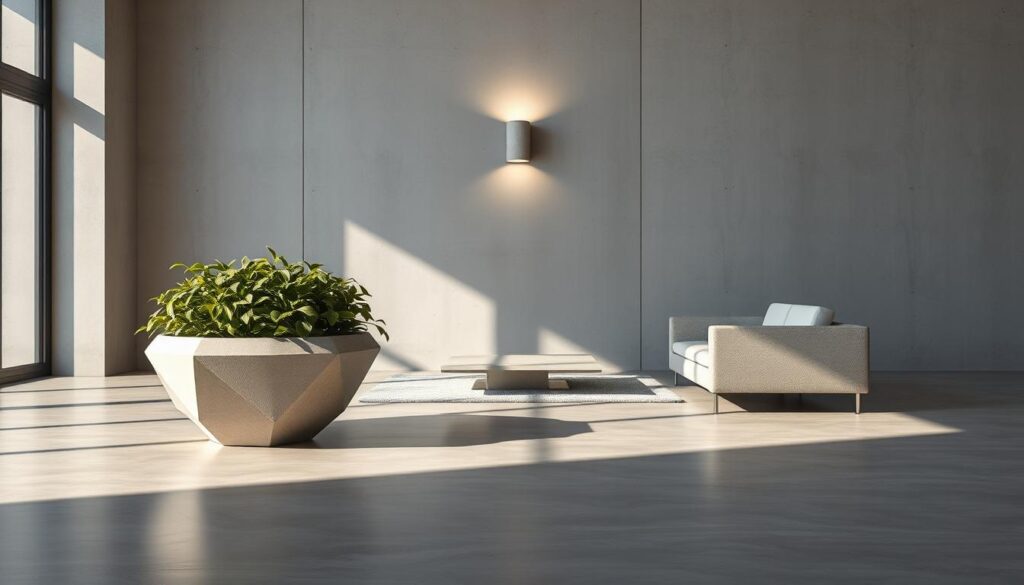
Stunning Furniture Choices
Concrete furniture is getting popular because it’s strong and looks modern. You can find everything from coffee tables to benches made of concrete. Here’s why you should consider concrete furniture:
- Durability: It’s very durable and can handle a lot of use.
- Versatility: You can shape it into many forms, giving you lots of design options.
- Aesthetic Appeal: It brings a modern, industrial look to any room.
Eye-Catching Art Pieces
Concrete isn’t just for furniture; it’s also great for art. You can make sculptures or wall hangings with it. These art pieces can be the highlight of any room. Here are some ways to use concrete in your decor:
- Make textured wall art with concrete to add depth to your walls.
- Put concrete sculptures in your garden or living area.
- Make decorative items like vases or candle holders out of concrete.
Unique Lighting Solutions
Lighting is key in home decor, and concrete can help create unique lights. You can find everything from lamps to chandeliers made of concrete. Here’s why concrete lighting is a good choice:
- Industrial Chic: It adds an industrial vibe to your decor.
- Customization: You can shape it into many forms, making customized lights.
In summary, concrete accents and decor can really improve your living space. Whether it’s furniture, art, or lights, concrete brings a modern touch to any room.
Overcoming Common Misconceptions
Concrete interior design is becoming more popular, but it faces some misconceptions. One big worry is that it feels cold and unwelcoming. But, we can fix this by mixing concrete with materials that add warmth and texture.
Addressing Perceived Coldness
To make a space feel warmer, we can use materials like wood, textiles, or metal with concrete. For example, adding wooden furniture or accents can make a room with concrete floors or walls feel cozy. Plush textiles like throw blankets, rugs, or upholstered furniture also bring a cozy feel to industrial spaces.
In minimalist concrete interiors, the right lighting is key to a welcoming feel. Warm lighting, not harsh overhead lights, makes a space feel inviting. Adding natural elements, like plants or a living wall, also brings warmth and life to a room.
Combatting the “Bland” Myth
Many think concrete interior design is bland and lacks character. But, concrete can be finished in many ways to create unique textures and colors. This makes it a great choice for interior design. From shiny polished floors to colorful stained concrete, there are many options.
| Finish Type | Description | Aesthetic Appeal |
|---|---|---|
| Polished Concrete | A high-gloss finish achieved through mechanical polishing | Modern, sleek, reflective |
| Stained Concrete | Color is introduced through acid-based stains | Rich, variegated, earthy tones |
| Textured Finishes | Various textures achieved through stamping or other techniques | Unique, tactile, can mimic other materials |
Understanding concrete’s versatility and how to pair it with other materials helps create beautiful, warm spaces. Whether using industrial interior design elements or natural materials, the possibilities with concrete are endless.
Mixing Materials with Concrete
By mixing concrete with other materials, homeowners can create a unique look. This mix adds beauty and function to the space.
Concrete, when mixed with other elements, makes a space look good and feel welcoming. The trick is to find the right mix of textures and materials.
Complementing Wood Elements
One great way to mix materials is by adding wood to concrete. This mix brings together warmth and modernity. Wood softens the hard feel of concrete.
For example, a concrete floor with wooden furniture makes a cozy living room. The contrast between the cool concrete and warm wood adds depth.
Benefits of Combining Concrete and Wood:
- Adds warmth to industrial spaces
- Creates a natural, organic feel
- Provides a visually appealing contrast
Integrating Metal Accents
Metal accents can make concrete look sleek and modern. Metal adds an industrial charm to concrete, from small accents to big pieces.
For instance, metal lights or screens can enhance concrete walls or floors. This mix is perfect for modern designs that like a simple look.
| Material | Aesthetic Appeal | Functional Benefits |
|---|---|---|
| Concrete & Wood | Warmth, natural touch | Durable, versatile |
| Concrete & Metal | Sleek, modern, industrial charm | Strong, durable, versatile |
Combining with Fabrics
Adding fabrics to concrete makes a space softer and more textured. Fabrics balance out the hard feel of concrete, making it cozy.
In urban concrete styles, fabrics like furniture upholstery or rugs make the space feel human. It’s all about balancing concrete’s heaviness with fabrics’ lightness.
The result is a chic concrete interior that feels both modern and welcoming.
Concrete in Commercial Spaces
Concrete is changing the game in commercial interiors, adding urban charm to spaces. It’s strong and versatile, making it a top pick for many uses.
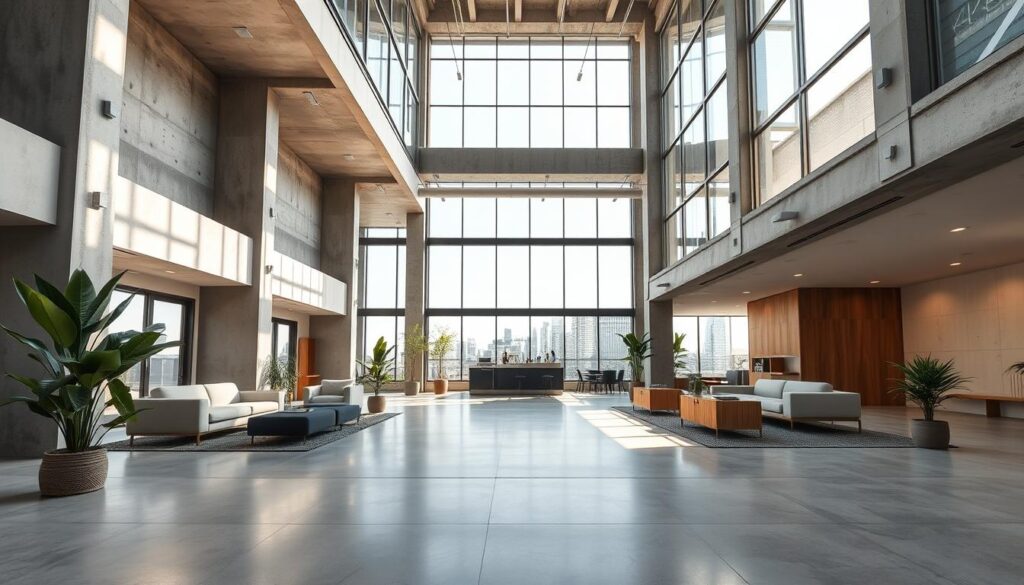
Retail Showrooms
In retail, concrete brings a modern, industrial vibe that draws in customers. Polished concrete floors are a hit because they’re tough and easy to keep up.
- Enhances the industrial charm of the space
- Durable and resistant to heavy foot traffic
- Easy to maintain and clean
Office Interiors
Concrete is also a hit in offices, creating open, airy spaces that boost creativity. Exposed concrete adds a touch of sophistication.
- Creates a modern and sleek look
- Can be used to create unique architectural features
- Provides a durable and long-lasting solution
Hospitality Design
In hospitality, concrete is used to craft stylish, welcoming spaces that show off the brand. From concrete bars to standout walls, it’s a canvas for creativity.
Modern concrete design is redefining what’s possible. It lets businesses create unique spaces that really pop in a crowded market.
Budgeting for Concrete Interior Projects
When planning to use concrete in your interior design, knowing the costs is key. This is true for both homes and businesses. A detailed budget is necessary to cover all project aspects.
Concrete can be cheaper than materials like marble or stone. But, the cost depends on the finish, how it’s applied, and the project’s complexity. Knowing these factors helps in making a more accurate budget.
Cost Breakdown
Breaking down costs is crucial for budgeting. Concrete projects have material, labor, and additional expenses.
| Cost Component | Description | Estimated Cost Range |
|---|---|---|
| Material Costs | Includes the cost of concrete, sealants, and any coloring or texturing agents. | $3 – $10 per square foot |
| Labor Costs | Costs associated with the preparation, application, and finishing of the concrete. | $2 – $5 per square foot |
| Additional Expenses | May include costs for specialized tools, equipment rental, and any necessary repairs or preparation work. | $1 – $3 per square foot |
DIY vs. Professional Help
Choosing between DIY or hiring professionals is a big decision. It affects your budget and the project’s success.
DIY Approach: DIY can save on labor costs. But, it takes a lot of time, skill, and knowledge about concrete. Mistakes can be expensive and might not be worth the savings.
Professional Help: Professionals ensure the project is done right and fast. They cost more upfront. But, they can suggest the most cost-effective methods and materials.
Financing Options
The cost of a concrete project can be a hurdle. Luckily, there are financing options to help.
- Home equity loans or lines of credit
- Personal loans
- Credit cards (for smaller projects or expenses)
- Contractor financing options
It’s important to look at these options carefully. Choose the one that fits your financial situation and project needs best.
Maintenance Tips for Concrete Surfaces
Concrete surfaces need some care to stay looking good and last long. Even though concrete is tough, regular upkeep can make it look better and last longer.
Cleaning Techniques
Cleaning concrete is easy. Just sweep or dust it daily. For a deeper clean, mix mild detergent with warm water. Don’t use harsh chemicals or abrasive cleaners, as they can harm the concrete or remove its sealant.
- Sweep or dust regularly to prevent dirt buildup.
- Use a mild detergent and warm water for deeper cleaning.
- Avoid harsh chemicals and abrasive cleaners.
Repairing Damages
Concrete can crack or get damaged, even though it’s durable. For small cracks, use a concrete patching compound. For bigger damages, you might need a pro. Regular checks can spot problems early.
- Inspect your concrete surfaces regularly for signs of damage.
- Use a concrete patching compound for small cracks.
- Consult a professional for larger or more complex repairs.
For more detailed guidance on maintaining decorative concrete floors, you can visit https://artcretedesigns.com/decorative-concrete-floors-maintenance for expert advice.
Sealing and Protecting
Sealing your concrete is key to keeping it looking great and protected. The right sealant depends on your concrete’s needs, like where it’s located and how it’s used.
- Choose a sealant that is appropriate for your concrete’s specific needs.
- Apply the sealant according to the manufacturer’s instructions.
- Reapply sealant as needed, typically every few years.
By following these tips, you can keep your concrete looking its best. It will remain a stunning part of your modern concrete design for many years.
Future of Concrete in Interior Design
Concrete is becoming more popular in interior design, and it’s here to stay. It brings a mix of urban style and modern elegance to our homes. The future of concrete in design looks bright, thanks to new technologies and creative ideas.
Advancements in Concrete Technology
New tech is making concrete designs more advanced and customizable. This change will be key in the future of concrete in design.
Innovative Design Approaches
Designers are finding new ways to use concrete in their work. This has led to the creation of unique and stunning spaces that show off concrete’s potential.
Emerging Trends
Looking ahead, several trends will shape concrete interior design. Sustainability will be a big focus, along with combining concrete with other materials for striking looks. The future of concrete in design is exciting, and we can’t wait to see what’s next.

